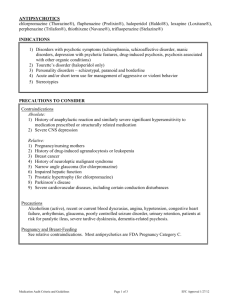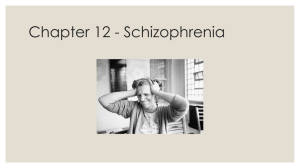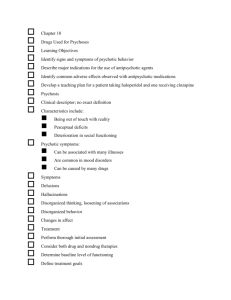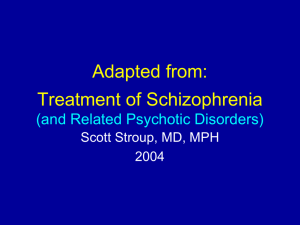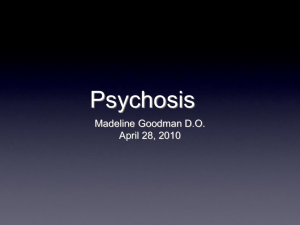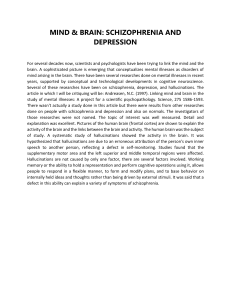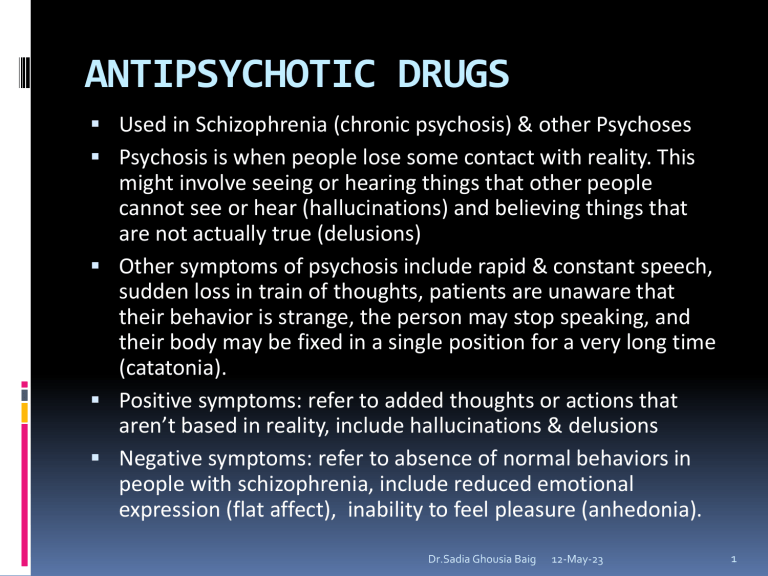
ANTIPSYCHOTIC DRUGS Used in Schizophrenia (chronic psychosis) & other Psychoses Psychosis is when people lose some contact with reality. This might involve seeing or hearing things that other people cannot see or hear (hallucinations) and believing things that are not actually true (delusions) Other symptoms of psychosis include rapid & constant speech, sudden loss in train of thoughts, patients are unaware that their behavior is strange, the person may stop speaking, and their body may be fixed in a single position for a very long time (catatonia). Positive symptoms: refer to added thoughts or actions that aren’t based in reality, include hallucinations & delusions Negative symptoms: refer to absence of normal behaviors in people with schizophrenia, include reduced emotional expression (flat affect), inability to feel pleasure (anhedonia). Dr.Sadia Ghousia Baig 12-May-23 1 Schizophrenia is a severe, chronic mental disorder characterized by disturbances in thought, perception and behavior . Dopamine transmission disorder is a primary factor A person is diagnosed with schizophrenia if they have at least two of these symptoms for at least 6 months: Delusions Hallucinations Disorganized speech Disorganized or catatonic behavior Negative symptoms One of the symptoms has to be Delusions Hallucinations Disorganized speech During the 6 months, the person must have a month of active symptoms. (It can be less with successful treatment.) Symptoms should negatively affect them socially or at work, and can’t be caused by any other condition. Dr.Sadia Ghousia Baig 12-May-23 2 Classification of Antipsychotics First generation include Phenothiazines ( chlorpromazine, Thioridazine, Fluphenazine), Thioxanthenes ( Thiothixene) & Butyrophenones ( Haloperidol). High potency antipsychotics have more affinity for D2 receptor & include Haloperidol, Fluphenazine, Thiothixene,Pimozide,Loxapine. Low potency include chlorpromazine & Thioridazine First generation high potency drugs cause movement disorders ( Extrapyramidal symptoms EPS) Egs: Dystonia( sustained contraction of muscles, distorted postures, occur in few hrs); Parkinson like symptoms ( bradykinesia, tremors , rigidity occur in weeks to months), akathisia (motor restlessness, occur in a day to weeks ); tardive dyskinesia ( involuntary movements of tongue,lips, neck, trunk ,limbs, occur after months or years of treatment) Second generation ( atypical) drugs have varied heterocyclic structures and include clozapine, loxapine, olanzapine, risperidone, quetiapine,ziprasidone, and aripiprazole Dr.Sadia Ghousia Baig 12-May-23 3 P/K & P/D The antipsychotic drugs are well absorbed when given orally, lipid soluble, readily enter CNS & other body tissues. Many are bound extensively to plasma proteins. These drugs require metabolism by liver enzymes before elimination & have long plasma halflives, drugs that inhibit CYP enzymes can prolong the halflives of antipsychotic agents. Parenteral forms of some agents (eg, fluphenazine, haloperidol, ziprasidone, olanzapine, and aripiprazole) are available Dopamine receptor blockade correlates with therapeutic benefit for first generation antipsychotic drugs. Dopaminergic tracts in the brain include the mesocortical mesolimbic pathways (regulating mood), nigrostriatal tract (extrapyramidal function), tuberoinfundibular pathways (control of prolactin release), and chemoreceptor trigger zone (emesis). Mesocortical mesolimbic dopamine receptor blockade presumably underlies antipsychotic effects & a similar action on the chemoreceptor trigger zone (CTZ) leads to the useful antiemetic properties almost all antipsychotic agents block both α1 and histamine H1 receptors to Dr.Sadia Ghousia Baig 12-May-23 some extent 4 USES OF ANTIPSYCHOTIC DRUGS Schizophrenia ( coventional antipsychotics reduce positive symptoms like hallucinations, work less on negative symptoms. Clozapine is used in treatment resistant cases ( use is limited due to S/E of agranulocytosis) Prevention & Treatment of acute mania (aripiprazole, olanzapine) Management of schizoaffective disorders Toxic psychoses( caused by over dose of CNS stimulants) Tourette syndrome ( to control tics, sudden repetitive movements or sounds for example blinking) Psychotic symptoms management in PD & AD Antiemetic ( Prochlorperazine) ADR: Sedation (chlorpromazine) , conduction defects & visual impairments by retinal deposits ( thioridazine), QT interval prolongation ( quetiapine, ziprasidone), seizures & agranulocytosis ( clozapine) , wt gain, hyperglycemia (clozapine. Olanzapine), hyperprolactinemia ( risperidone), amenorrhea, gynecomastia , postural hypotension, EPS NMS ( neuroleptic malignat syndrome) : reaction to antipsychotic drugs characterized by muscle rigidity, hyperpyrexia, bp changes. treated by dantrolene , diazepam, dopamine agonist drugs. Most common by haloperidol, chlorpromazine. Dr.Sadia Ghousia Baig 12-May-23 5
